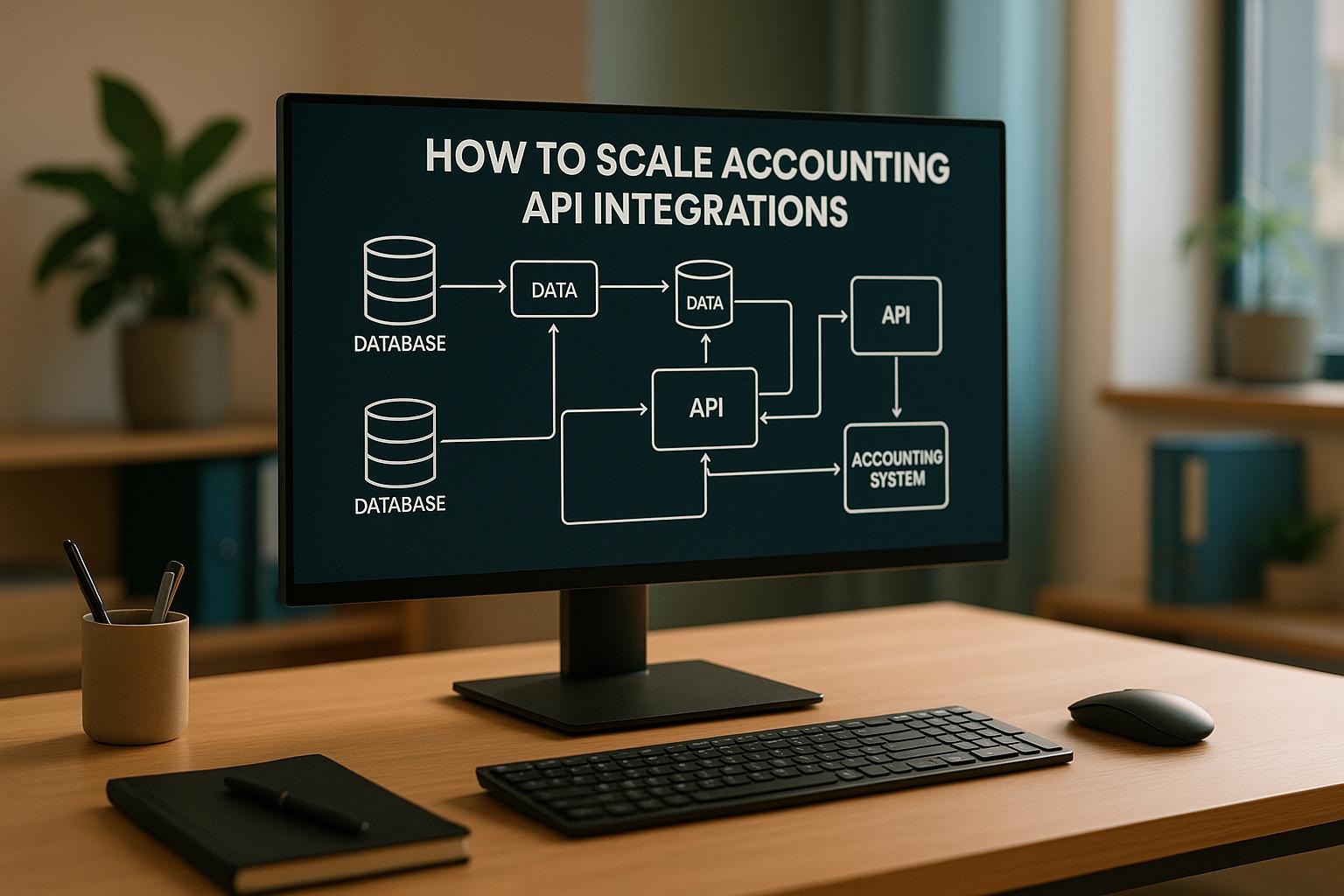How to Scale Accounting API Integrations

Scaling accounting API integrations is all about ensuring your systems can handle growth without breaking under the pressure of increasing transaction volumes. Here’s what you need to know:
- Why It Matters: As businesses grow, transaction volumes can jump from hundreds to thousands daily. Without scalable systems, this growth can cause delays, errors, and disruptions in financial operations.
- Key Challenges: Common issues include API rate limits, delays in data synchronization, compliance with regulations like GAAP and PCI DSS, and managing errors at scale.
- Solutions:
- Use modular API architecture to scale specific components (like payments) without affecting the entire system.
- Implement unified API platforms to simplify managing multiple accounting tools like QuickBooks or Xero.
- Focus on real-time data processing to eliminate delays and maintain consistent financial records.
- Tools to Consider: Platforms like MuleSoft, Power Automate, and Zapier offer varying levels of scalability and ease of use. Unified APIs like Merge can simplify integration complexity.
- Best Practices: Ensure strong security (OAuth 2.0, encryption), maintain compliance with U.S. standards, and plan for error handling and disaster recovery.
Modular Architecture and Scalable API Design
Benefits of Modular API Architectures
Modular API architecture breaks down complex integrations into independent, reusable modules that can be developed, tested, and maintained separately. This setup gives growing companies the flexibility that traditional monolithic systems often lack.
One big advantage is independent scaling. For example, if your payment module needs to handle a holiday rush, you can scale just that part without affecting other components. This targeted approach not only boosts performance where it’s needed but also helps cut unnecessary costs.
Another benefit is faster development cycles. Teams can work on individual modules in parallel, speeding up updates. Let’s say your accounts receivable module needs a tweak - developers can make changes without touching payroll or expense management, keeping everything else running smoothly.
Error isolation is also a game-changer. If one module, like bank reconciliation, runs into trouble, it won’t bring down the entire system. Other modules, such as invoice processing or payment collection, can continue operating without interruption. This reduces the risk of a single failure affecting the entire operation.
Lastly, modular design offers flexibility with vendor relationships. You’re not tied to one accounting platform or integration provider. If you decide to switch systems, you only need to update the affected modules, leaving the rest of your setup untouched.
These advantages make modular architecture a strong foundation for unified API platforms and better API designs.
Using Unified API Platforms
Unified API platforms solve a common challenge in accounting integrations: managing multiple API connections. Instead of building separate integrations for tools like QuickBooks, Xero, or NetSuite, a unified API provides one connection point to handle the complexity for you.
These platforms act as middlemen between your business apps and various accounting systems. For instance, when your CRM needs to create an invoice, it sends a single, standardized request to the unified API. The platform then translates that request into the format required by the accounting software you’re using. This eliminates the need to learn and maintain multiple API specifications.
Another major perk is data standardization. Different accounting systems often use inconsistent labels - what one calls a "customer", another might call a "contact." Unified APIs smooth out these differences, making it easier to create reports and analytics that work across platforms.
Cost savings are another bonus. With fewer integrations to build and maintain, your team can spend more time improving business logic and user experiences rather than troubleshooting connections.
Design Principles for Scalable APIs
Building scalable APIs starts with version control. Use semantic versioning (like v1.0, v1.1, v2.0) from the outset. This ensures that when changes are needed - whether to handle more transactions or add new features - existing integrations won’t break while new ones adopt the updated version.
Endpoint optimization is also key. Design endpoints to return only the data that’s needed. For example, instead of a single endpoint that dumps all customer data, create focused endpoints like /customers/basic-info or /customers/transaction-history. This approach reduces bandwidth usage and speeds up response times.
For handling large datasets, pagination and filtering are essential. Cursor-based pagination works well for managing big data loads, while filters like date, status, or page size help prevent server overloads.
Asynchronous processing is critical for high-volume operations. Bulk tasks, like importing a large number of transactions, should be handled in the background using job queues. Status endpoints can let clients track progress without risking timeouts, keeping the system responsive.
To handle traffic spikes, rate limiting and throttling are must-haves. Implement tiered rate limits to balance client needs and system performance. Including rate limit headers in API responses can also help clients manage their usage more effectively.
Finally, comprehensive error handling is vital as integrations grow more complex. Provide clear error codes and messages to make troubleshooting easier. Instead of vague "400 Bad Request" responses, use specific codes like "INVALID_ACCOUNT_ID" or "DUPLICATE_TRANSACTION", along with actionable explanations for resolving the issue.
Automation and Real-Time Data Processing
Automating Financial Workflows
Using a modular system design makes automation and synchronization more efficient, allowing businesses to scale operations seamlessly. For example, automating invoice processing can handle tasks like extracting data, verifying vendor details, and routing approvals. Similarly, payment reconciliation can instantly match incoming payments with invoices, eliminating the need to manually compare bank statements with accounting records. These workflows can process hundreds of transactions within minutes, flagging only the exceptions that require human review.
Automation also simplifies reporting and expense management, cutting down manual effort while ensuring compliance. Systems can pull data from various sources, apply business rules, and generate financial reports on a set schedule. Monthly close processes that used to take weeks can now be completed in just a few days, freeing finance teams to focus on analysis rather than data entry.
Expense management tools take automation further by capturing receipts through mobile apps, categorizing expenses with machine learning, and submitting them for approval based on company policies. These systems are designed to identify when human input is necessary - such as when vendor details don’t align with existing records or when payment amounts deviate from expected ranges - and route the issue to the right team member.
By automating these repetitive tasks, businesses not only save time but also ensure that any updates are reflected across systems in real-time.
Real-Time Data Synchronization
Real-time data synchronization keeps financial information consistent across all connected systems, eliminating the delays and errors often caused by batch processing. For instance, when a customer payment is recorded in your payment processor, it should immediately update your accounting software, CRM, and business intelligence dashboards.
An event-driven architecture ensures that updates are pushed instantly, allowing all systems to display accurate, up-to-date information. This is particularly critical for businesses managing high transaction volumes, where outdated data can lead to poor decisions.
To prevent conflicts when multiple systems update the same record simultaneously, clear time-stamped rules are essential. These rules - based on time-stamping, source prioritization, and user-defined business logic - ensure that the correct version of the record is retained.
Monitoring and alerting systems play a key role in maintaining synchronization. They track performance, notify administrators of delays or failures, and help resolve issues before they disrupt operations. This proactive approach ensures data integrity and smooth business processes.
Documentation and Testing Requirements
Supporting automation and real-time processes requires thorough documentation and rigorous testing. Comprehensive API documentation, automated testing (including unit, integration, and end-to-end tests), and detailed disaster recovery procedures are all critical for maintaining system reliability and resolving issues quickly.
Ongoing performance testing ensures that systems can handle the expected transaction volumes without slowing down. Load testing helps pinpoint bottlenecks before they become a problem, while stress testing reveals how systems react under extreme conditions. These practices ensure that automated workflows and real-time synchronization continue to operate smoothly, even as demands grow.
Tools and Methods for Scalable Integration
API Integration Tools
When it comes to scalable accounting API integrations, iPaaS solutions play a central role. MuleSoft Anypoint Platform stands out for enterprise-level needs, offering a wide array of pre-built connectors tailored for major accounting systems. It’s particularly suited for handling large transaction volumes efficiently.
For mid-sized businesses, Microsoft Power Automate provides a more accessible option. Its drag-and-drop workflow builder makes it easy to connect accounting software with CRM systems, payment processors, and reporting tools. Plus, its library of pre-configured workflows simplifies financial processes significantly.
If you’re looking for something straightforward and quick to set up, Zapier is a great choice. While not as advanced as enterprise platforms, it’s reliable for moderate transaction volumes and ensures smooth data flows for critical financial operations.
For developers aiming to save time, unified API platforms like Merge and Alloy are worth considering. These platforms simplify integration by offering a single interface, taking care of tasks like authentication, data normalization, and rate limiting automatically.
To ensure everything runs smoothly, monitoring tools such as Datadog and New Relic can track API performance in real time. They monitor metrics like response times and error rates, alerting teams to any unusual activity so they can act quickly during high-demand periods.
These tools offer a range of options to meet the scalability, compliance, and cost considerations of different businesses.
How to Select Integration Tools
Choosing the right integration tool requires careful evaluation of your business needs. Scalability should be a key focus - consider how well a platform handles growing transaction volumes, concurrent connections, and increasing data loads. Tools that support horizontal scaling can expand seamlessly as your business grows, while others might eventually hit capacity limits.
Another critical factor is data normalization, which ensures consistency across systems. Platforms that automatically standardize formats like currency and dates can save time and reduce errors in financial reports.
Security and compliance are non-negotiable. Look for tools with features like U.S.-compliant authentication, multi-factor authentication, and encryption for data in transit and at rest. Audit trails to track data access and automated data retention policies can help meet regulatory requirements, including those under SOX.
If your business operates under U.S. compliance standards, consider tools with built-in features for GAAP-compliant financial data formatting and seamless integration with tax preparation software. Geographic data residency controls and automated reporting functions can also simplify compliance.
Finally, don’t overlook pricing. Enterprise solutions often charge based on API call volume or data usage, while simpler tools might offer flat-rate pricing. Weigh your current needs against future growth to pick a solution that balances cost with scalability.
Integration Tool Comparison
| Tool Category | Scalability | Maintenance Requirements | Compliance Features | Pricing Considerations |
|---|---|---|---|---|
| Enterprise iPaaS (e.g., MuleSoft, Boomi) | High | Moderate – may require technical support | Comprehensive, meets financial regulations | Higher investment required |
| Mid-Market Platforms (e.g., Microsoft Power Automate, Workato) | Moderate – good for growing volumes | Low – user-friendly, visual workflow builders | Standard security and compliance protocols | Moderately priced |
| Simple Automation (e.g., Zapier, Integromat) | Best for lower to moderate volumes | Minimal – easy, template-driven setup | Basic security and compliance | Cost-effective, upgrades may be needed for growth |
| Unified APIs (e.g., Merge, Alloy) | Variable – depends on infrastructure | Low – pre-built connectors streamline setup | Varies by provider | Usage-based pricing tied to complexity |
This table highlights the strengths and trade-offs of different tools. Enterprise iPaaS platforms deliver unmatched scalability and robust compliance features but often require a higher investment and technical expertise. Mid-market platforms are ideal for growing businesses, offering a balance of functionality and ease of use. For simpler needs, automation tools like Zapier are a cost-effective choice, while unified API platforms offer a flexible solution for reducing integration complexity. By aligning your choice with your business’s transaction volume, growth expectations, and technical capabilities, you can ensure your integration tool supports your needs effectively.
sbb-itb-e766981
Compliance, Security, and Maintenance Best Practices
U.S. Compliance Requirements for Financial Data
When dealing with financial APIs in the U.S., staying compliant with key regulations like SOX, GAAP, CCPA, and PCI DSS is non-negotiable. Each of these laws plays a critical role in ensuring data integrity and security.
SOX compliance focuses on maintaining accurate financial records with detailed audit trails to track all transaction activity. GAAP ensures financial reporting is consistent, covering areas like revenue recognition and categorizing expenses properly.
For organizations managing personal financial data, CCPA compliance means being ready to handle data deletion requests, provide data portability, and document all data processing activities. If payment card data is involved, PCI DSS compliance is essential. This includes measures like encryption, tokenization, and segmenting networks to safeguard sensitive information.
APIs should also be designed to handle sales tax calculations effectively, document tax processes for audits, and adjust to any regulatory updates. These practices not only ensure compliance but also establish a secure foundation for managing financial data.
API Security Best Practices
Securing APIs starts with implementing OAuth 2.0 for authentication, which ensures only authorized users or systems can access your API. Choose the right OAuth 2.0 flow based on your application's needs, and set token expiration times to minimize exposure to risks.
Enforce rate limits to prevent misuse, and encrypt sensitive data both in transit and at rest. Regularly rotate API keys and manage them securely using secret management tools instead of embedding them in code. Input validation and sanitization are crucial to stopping injection attacks and preventing data corruption. Additionally, continuous monitoring helps identify and respond to potential threats before they escalate.
By following these security measures, you create a safer environment for both API operations and maintenance.
Maintenance and Error Handling
Effective API maintenance relies on practices like clear versioning, such as semantic versioning, and maintaining backward compatibility. Always provide deprecation notices and migration timelines to help users adapt to changes smoothly.
Error handling should focus on delivering clear, precise responses without exposing sensitive details. Automate unit, integration, and performance testing to catch issues early, and continuously monitor system performance to ensure reliability.
Prepare for the unexpected with a robust disaster recovery plan. This includes regular backups, tested recovery procedures, and capacity planning to handle growing demands. Keeping documentation up to date and planning for future capacity ensures your APIs remain scalable and resilient over time.
Scaling Success with Expert Guidance
Here’s a closer look at the key points for implementing scalable accounting API integrations effectively.
Key Takeaways for Scalable Accounting API Integrations
Building scalable accounting API integrations starts with a well-thought-out, modular design. This approach ensures your system can handle growth without requiring major overhauls. APIs should be equipped to manage increasing transaction volumes while maintaining strong performance and reliability.
Automation is another cornerstone of scalability. Real-time data synchronization minimizes manual data entry errors and keeps financial reports aligned with current business conditions. When paired with thorough documentation and rigorous testing protocols, automated workflows become the backbone of a dependable financial system.
Selecting the right tools is essential for long-term success. Your integration platform should be flexible enough to accommodate new accounting systems as your business grows. Key factors to evaluate include API rate limits, data transformation capabilities, and compatibility with multiple accounting platforms.
Security and compliance should be integral to your API architecture from the outset. Proactive measures like regular security assessments and ongoing maintenance help ensure your integrations remain secure and reliable as transaction volumes expand.
For businesses seeking expert guidance in these areas, Phoenix Strategy Group offers tailored solutions to help you scale with confidence.
How Phoenix Strategy Group Can Help

Phoenix Strategy Group brings a wealth of expertise to businesses navigating the challenges of scaling. Their data engineering and financial advisory services are designed to ensure your accounting APIs grow seamlessly alongside your business.
Their integrated approach combines technical execution with strategic financial planning. By aligning data engineering with fractional CFO services, they create financial systems that go beyond data transfer. These systems provide actionable insights into key metrics like unit economics and cash flow, empowering better decision-making.
For companies preparing for expansion, Phoenix Strategy Group’s experience in M&A advisory and fundraising support is invaluable. They understand what investors and acquirers look for in financial systems, ensuring your API integrations meet the due diligence standards required for successful funding rounds or acquisitions. Their Monday Morning Metrics framework helps leadership teams track the most critical KPIs during periods of rapid growth.
Backed by extensive experience with growth-stage companies, Phoenix Strategy Group offers proven strategies to scale accounting operations efficiently and effectively.
FAQs
What are the key advantages of using modular API architecture to scale accounting integrations?
A modular API architecture brings a host of benefits to accounting integrations, including scalability, flexibility, and efficiency. By enabling individual components to function and evolve independently, this approach ensures your systems can expand smoothly alongside your growing business. This is particularly helpful for companies in growth stages, where financial processes often become more complex.
Another advantage of modular design is its focus on reusability. It simplifies integration, making it easier to roll out new features and handle system maintenance without unnecessary hassle. These qualities not only streamline operations but also cut down on development time, creating a strong foundation for your financial systems to keep up with long-term growth.
How do unified API platforms streamline managing multiple accounting tools?
Unified API platforms simplify the challenge of juggling multiple accounting tools by offering a single, standardized interface. Instead of dealing with various data formats or managing separate authentication processes, these platforms make integrations more efficient and reduce the likelihood of errors.
They also deliver real-time insights and cut down the time it takes to implement new integrations. For growing companies, this means they can scale operations more quickly. By centralizing financial data into one easily accessible system, businesses gain clearer control and visibility over their accounting processes, paving the way for smarter decisions and steady growth.
What are the key security and compliance steps for scaling accounting API integrations?
When expanding accounting API integrations, security and compliance should be at the forefront to safeguard sensitive financial information and align with regulatory requirements.
On the security front, implement key measures like HTTPS encryption, OAuth or API key authentication, and role-based access control to manage access effectively. A Zero-Trust model is also a smart choice - it operates on the principle that no user or system is automatically trusted, significantly minimizing the chances of unauthorized access.
For compliance, make sure data is encrypted both in transit and at rest to protect it at all stages. Meeting standards such as SOC 2 Type II is crucial for satisfying U.S. regulations and reinforcing stakeholder confidence. These practices not only help you scale safely but also lay the groundwork for sustainable growth.




